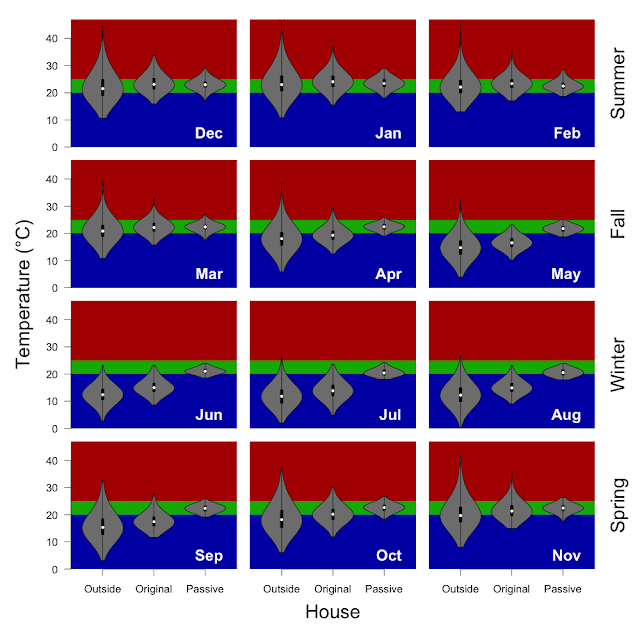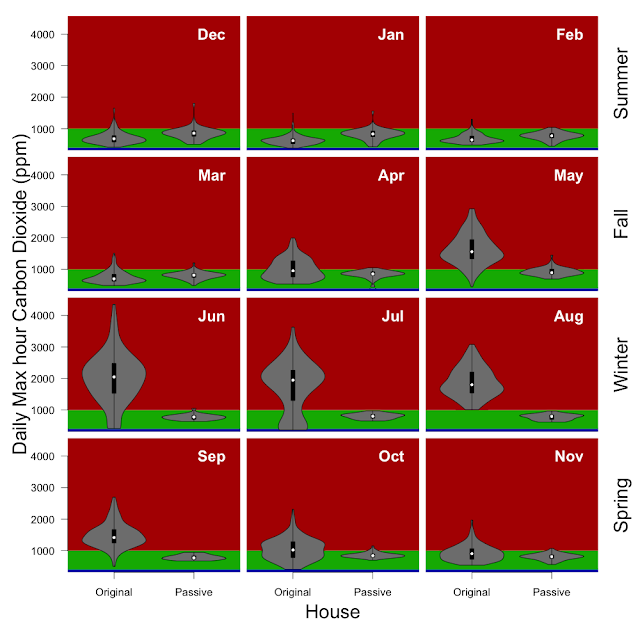Solar reflections
Our solar has been installed and generating for a year now... and enphase is really good at making data available. So I've been looking at our solar data and playing some what if games. For these purposes I am taking our electicity data from the enphase monthly reports - which do not include our garage power usage due to the way the our house is wired, but that usage is quite trivial so I am going to ignore it. The enphase system reports data (power generated, power imported, power consumed and power exported) in 15 minute intervals. I've include all the data which means I've got a little over 13 months of data to work with. Keep in mind that we have a great big tree on the east side of our house that significantly shades our solar panels for most of the morning, and a decent tree on the west that provides some partial shade especially in the later afternoon.
| Month | Produced | Consumed | Exported | Imported | Net |
|---|---|---|---|---|---|
| Jan | 16.0 | 11.7 | 9.4 | 5.1 | 4.3 |
| Feb | 14.7 | 10.1 | 9.1 | 4.6 | 4.6 |
| Mar | 12.6 | 11.0 | 7.2 | 5.6 | 1.5 |
| Apr | 12.4 | 13.2 | 6.2 | 7 | -0.8 |
| May | 12.3 | 13.5 | 6.0 | 7.2 | -1.2 |
| Jun | 12.5 | 15.1 | 6.4 | 9.0 | -2.6 |
| Jul | 11.6 | 15.6 | 5.8 | 9.8 | -4 |
| Aug | 15.0 | 14.8 | 8.4 | 8.2 | 0.2 |
| Sep | 15.3 | 11.1 | 9.1 | 4.9 | 4.2 |
| Oct | 15.2 | 11.6 | 8.9 | 5.3 | 3.6 |
| Nov | 18.4 | 12.7 | 10.7 | 4.9 | 5.7 |
| Dec | 14.6 | 12.1 | 7.8 | 5.3 | 2.5 |
Overall summary:
Daily electricity production and consumption. The lighter shade boxes are the average values, where as the blue (production) and red (consumption) are daily values with the black line being the daily net value.
A theoretical battery:
Let's assume for the moment that we have a battery that has 96% round trip efficiency and 100% discharge capacity (Enphase). Using the 15 minute data as the basis of a simulation we can model the revised grid import / export for different battery sizes.
In theory a battery sized to match the average import / export would be capable of enabling energy independence, but of course practice is not theory and cloudy days tend to be clustered. As a result even a really large battery would not enable complete independence from the electricity grid. In the table below the final column headed "% zero-import is the percentage of days with no electricity imported from the grid.
| Battery | Produced | Imported | Consumed | Exported | % zero-import |
|---|---|---|---|---|---|
| None | 14.1 | 6.3 | 12.6 | 7.9 | 0% |
| 3.4 | 14.1 | 3.3 | 12.6 | 4.6 | 11% |
| 6.7 | 14.1 | 2.2 | 12.6 | 3.3 | 48% |
| 10.1 | 14.1 | 1.7 | 12.6 | 2.8 | 61% |
| 13.5 | 14.1 | 1.5 | 12.6 | 2.5 | 69% |
The money side:
Since disconnecting from the grid is not really an option, a daily connection fee is a given (so we will ignore that cost for now). We pay about 3x more for power from the grid than we get for power we put back into the grid. For the sake of easy math we could say $0.3 for imports and $0.1 for exports (per kWh). Given the relatively small numbers (kWh) it is not surprising the costs (as well as the savings) are also very small. So cost alone isn't a justification for a battery system and it is likely to be a while before a 6.7kWh battery system will cost less than $281 per year in savings that it would be modeled to generate over its warranteed life. Even assuming that the grid no longer pays for returned energy the cost of a 6.7kW battery would save ~ $449 per year. For a 13.5kWh battery such as the Tesla Powerwall2 and assuming that the grid does not pay for returned energy the cost of the battery would need to be less than $5259.60 for it to be justified on economic grounds (assuming a 10 yr warrantee period). Given that these batteries currently cost ~ $12k the cost of electricity would need to almost double ($0.52/kWh) for the battery to be justified on cost alone.
| Battery | Imported (kWh) | Imported ($) | Exported (kWh) | Exported ($) | Net Cost (pa) |
|---|---|---|---|---|---|
| No Panels | 12.6 | $3.78 | 0 | $0 | $1381 |
| No Battery | 6.3 | $1.89 | 7.9 | $0.79 | $402 |
| 3.4 kWh Battery | 3.3 | $0.99 | 4.6 | $0.46 | $194 |
| 6.7 kWh Battery | 2.2 | $0.66 | 3.3 | $0.33 | $121 |
| 10.1 kWh Battery | 1.7 | $0.51 | 2.8 | $0.28 | $84 |
| 13.5 kWh Battery | 1.5 | $0.45 | 2.5 | $0.25 | $73 |
The take home:
Our solar panels save us ~ $979 pa in electricity costs and will definielty pay for themselves. In a world without variance it would be relatively easy to become independent of the electricity grid, but cloudy days are clustered in time (Just this month with had 4 days in a row where we produced less than 3kWh per day), so in reality it is quite difficult to be completely independent. The other thing that we have not considered here is time of day tarrifs -- especially if the battery could be programed to take advantage of periods with cheaper electricity costs (although preliminary modeling suggests it would not result in enough savings to justify the costs of the batteries). Virtual power plant participation would also likely shift the math a bit, but again - the amount available to save (~ 2.3mWh pa total import) means that only significant increases in power prices or notable decreases in battery prices would be required to justify batteries on the basis of cost savings alone.



